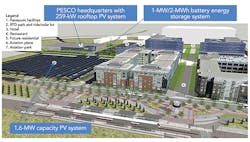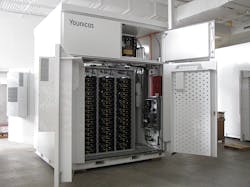Xcel Energy is tackling battery storage through two separate pilot projects in Denver, Colorado, U.S. The first project will use a battery to create a microgrid for a large technology company that just relocated its enterprise division to the area. The second project will evaluate how a network of front-of-the-meter utility-scale batteries and behind-the-meter in-home batteries can be used to integrate and store a high penetration of solar energy on a distribution feeder.
Xcel Energy’s battery demonstration at a new Panasonic corporate facility was approved in March 2016 by the Colorado Public Utilities Commission under the utility’s Innovative Clean Technology (ICT) program. Established in 2009, the ICT effort provides Xcel Energy the ability to test new technologies and evaluate their cost, reliability and environmental performance in a small demonstration scale before determining whether the technology is cost effective and ready to be deployed more widely for customers.
Panasonic Pilot
Through a unique partnership between Xcel Energy, Panasonic and the Denver International Airport (DIA), the battery demonstration project aims to examine complementary value propositions that maximize a battery’s economic potential by providing value for both the utility and customers.
For the pilot, Xcel Energy will own and operate a battery storage system to help facilitate the integration of renewable energy, enhance the reliability of the distribution system, and assist in providing voltage management and peak energy demand reduction. This project will be located on a feeder that already has 20% solar penetration and will increase to 30% by the time the project is completed. A portion of the battery system also will be reserved to provide power to Panasonic in case of an outage. The technology company’s network operations center — which monitors and manages a nationwide network of large-scale solar photovoltaic (PV) projects, totaling hundreds of megawatts — is located at its new Denver facility.
The four primary components of the Panasonic project include a 1.6-MW direct-current (DC) carport solar installation, a 259-kW DC rooftop PV system at Panasonic’s new corporate facility, a 1-MW/2-MWh lithium-ion battery, and switching and control systems to operate the energy storage system and microgrid functionality.
Over the course of a two-year demonstration, the system will be tested under multiple scenarios to determine how it can be used to increase reliability and resiliency for both Xcel Energy’s grid and Panasonic.
As a clean-energy-solutions company focused on solar and solar+storage, Panasonic is interested in learning and experimenting with leveraging storage to build a cleaner, more reliable electricity grid of the future. DIA hopes the project will showcase microgrid and battery elements that may support the airport’s future growth in aviation and commercial activities by improving the resiliency of its assets as well as better integrating its loads with the surrounding grid.
Airport Involvement
Panasonic’s Denver operations hub is located within the new 400-acre (162-hectare) Peña station NEXT development, southwest of DIA. Its campus is part of a public-private collaboration whose goal is to build a community with renewable energy, autonomous vehicles, sustainable construction, and shops and restaurants intermingled with community centers, playgrounds, bike paths and public transportation. Panasonic moved into its new 115,000-sq-ft (10,684-sq-m) facility in September 2016.
The total estimated cost of the Panasonic battery project is US$10.3 million, of which $3.6 million is being contributed by the project’s partners, with Panasonic providing preferential pricing in construction, maintenance and labor ($1.1 million), and DIA funding the carport canopy structure supporting the 1.6-MW DC of PV generation at a cost of $2.5 million. As owner of the carport structure, DIA will be able to charge for covered parking, while Xcel Energy will have a long-term lease arrangement in which it owns the solar on the carport. Xcel Energy also will own the battery; it will be sited at Panasonic’s facility and Panasonic will maintain it.
Battery System Components
Construction on the Panasonic project started in November 2016. The carport solar became operational at the end of January 2017; the 1-MW/2-MWh lithium-ion batteries will be installed in March 2017. The battery system itself will be comprised of multiple Younicos Y.Cubes. When connected to the Xcel Energy power grid, the Y.Cube battery system will provide frequency regulation, solar grid integration through ramp control and solar time shifting, grid peak shaving, energy arbitrage and backup power — enabled by Younicos intelligent Y.Q storage control software.
The Y.Cube consists of two sub-enclosures, one each for the power conversion system (PCS) and DC battery block. The controls are embedded in the PCS and communicate directly with the battery system, bypassing the need for additional battery-to-PCS communication interfaces. Its optimized configuration translates to an ultrafast response time for improved PCS efficiency and enhanced grid-forming capability.
During the pilot, the Panasonic battery will help to manage solar generation through both solar smoothing and solar time shifting. In a smoothing mode, the battery will charge and discharge to minimize rapid fluctuations in PV output as well as regulate voltage increases. The two PV systems in this project — the carport PV and Panasonic’s rooftop PV — will be monitored and serve as a proxy for all solar generation on the feeder. In a solar time-shifting mode, the battery will store excess solar generation when output is high and dispatch energy later in the day. This approach helps to reduce system feeder peak.
Outage Response
The Panasonic partners also are interested in investigating the possibility of providing customers with added resiliency. This is achieved by using a microgrid to provide backup service in case of a grid outage. This solution may be more cost-effective than traditional solutions, such as providing customers access to an alternate feeder through costly line extensions and the use of automatic throw-over (ATO) switches. This solution could prove to be ideal for customers in remote locations or where alternatives are otherwise cost prohibitive.
In the event of a grid outage, the battery storage system will activate an islanding switch and automatically form a microgrid, allowing the battery to provide power to the Panasonic building. In this microgrid mode, both the battery and rooftop PV will provide power to Panasonic, whose intelligent building can prioritize and shed noncritical loads to keep critical services such as the network operations center up and running. Should power from the PV system exceed the building’s needs, any excess energy will be stored in the battery.
Once grid power has been restored, the microgrid will transition out of islanding mode and back to grid-following mode. This is accomplished by having an inverter-based generator sync with grid conditions and allowing a closed transition switch to connect back to the grid. To ensure it is stable, the grid must maintain a steady state for five minutes before leaving islanding mode.
After the two-year Panasonic pilot is complete and the data collected has been analyzed, the battery will operate at its optimal settings. It will function at these settings for the rest of its life span, which is approximately eight additional years, or about 10 years total.
The Stapleton Project
Meanwhile, Xcel Energy will be running a second battery storage pilot project in another Denver neighborhood, not too far away from the Panasonic project. Over the next two years, the utility will be testing six behind-the-meter in-home battery units and six front-of-the-meter utility-scale units along a feeder that is experiencing a high penetration of rooftop solar energy in the Stapleton neighborhood.
A key objective of the pilot includes increasing the ability to accommodate more solar energy on Xcel Energy’s distribution grid. This includes storing excess solar power during the day and discharging stored power during peak energy usage times. The utility also hopes to learn more about regulating voltage spikes on the system and reducing energy costs.
Distributed Storage Strategy
The network of front-of-the-meter battery locations will be on either end of the feeder’s half loop and paired to match the entire loop’s reverse power flow. By operating the batteries this way, Xcel Energy’s goal is to minimize the impacts of solar on the feeder, reduce the peak demand on the feeder, and reduce its marginal cost of energy by storing power at a lower cost and discharging it at a higher cost.
Northern Reliability Inc. (NRI) will supply the six modular utility-scale batteries to be used in the Stapleton pilot. NRI will be building two 18-kW batteries, two 36-kW batteries and two 54-kW batteries, totaling approximately 850 kWh of capacity. The NRI system uses U.S.-made energy conversion components from Pika Energy, along with advanced lithium-ion batteries.
While NRI sees the resiliency and redundancy of the Stapleton project’s systems as incredibly forward thinking, it also sees the pilot as an exciting opportunity to bring distributed storage resources one step closer to widespread adoption by using its control systems and fleet management software. The utility also looks forward to understanding the real-time power-quality management needed for a local grid with high PV generation.
Pilot Composition
For the Stapleton pilot project, Xcel Energy also recruited six homeowners with rooftop solar systems on the feeder to participate in the in-home battery pilot project. Sunverge Energy is supplying the behind-the-meter batteries and control software. Homeowners participating in the pilot will keep the home battery storage system at no cost when the pilot is complete and enjoy the benefits of reliable backup battery power in the rare event of a grid outage.
Sunverge’s cloud-based platform will enable Xcel Energy to control individual Sunverge storage systems and aggregate them into a virtual power plant. This modest investment in storage can translate into less need for feeder upgrades, or the ability to accommodate more solar energy on a feeder. The Stapleton pilot project is estimated to cost $4 million. The in-home batteries are scheduled to be installed and online in the spring. The utility-scale batteries are expected to be installed and live in the fall.
Building to the Future
Both projects will expand on the findings of Xcel Energy’s community energy storage project from the utility’s previous ICT program at the Solar Technology Acceleration Center (SolarTAC) in Aurora, Colorado. That project demonstrated how battery storage can help to integrate PV onto the grid by providing ramp rate control and smoothing of distributed solar generation.
Beth Chacon is the director of grid storage and emerging technologies for Xcel Energy’s advanced grid intelligence and security initiative. She leads the battery efforts in the utility’s distribution area and oversees the Panasonic and Stapleton battery pilot projects. Chacon previously supported the environmental initiatives in the company’s environmental policy department.




